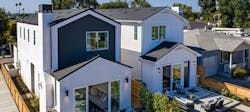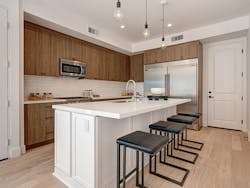Buying a teardown and building new isn’t a unique business model for home builders, but Thomas James Homes has a secret sauce for finding scattered lots in neighborhoods with high demand and low supply. Thomas Beadel and James Quandt co-founded their Los Angeles-based company in 2006, initially to flip foreclosed homes. On its way to generating $300 million in annual revenue from selling about 100 homes last year, the builder became part of Oaktree Capital Management and began expanding from West L.A. to Silicon Valley and Seattle by splitting single parcels and building side-by-side duplexes. Beadel shares how the recent launch of Trademark by TJH, a collection of two-story homes ranging from 1,463 to 1,930 square feet, fits that strategy.
PRO BUILDER: What’s your mission?
Thomas Beadel: We’re trying to make homeownership attainable for more people in prime neighborhoods on the west side of Los Angeles and in Silicon Valley and Seattle. We’re a one-for-one home builder, so we buy an existing home that, on average, is 80 years old, tear it down, and build a new house in its place.
PB: What’s your biggest challenge?
TB: The challenge is how to do that on a one-house basis, when land prices are based on the existing value of the home that’s on that property, and those homes aren’t decreasing in value. So, with land constantly going up in price, how do you drop the price to where you can sell somebody a brand new home? The only way to do that is by densification—getting multiple homes, which you can sell at the same time, on that parcel.
If we bought a parcel on the map for $1 million and built a new house, we’d probably have to sell that home for over $2 million. If we can cut that land price in half by building two houses there, then we can sell each fee simple, which cuts your land price to $500,000 per home and means you don’t have to sell one house for $2 million, you can sell two houses for closer to a million each. That’s the math problem of densification. Building more than one home on an existing parcel allows you to bring down your land basis for each unit and therefore bring down your sales price. That was the challenge we saw in the marketplace: How do you lower the price to get to more people? And densification is how we create that pricing model.
PB: How did you deal with zoning and with NIMBYs opposed to higher density?
TB: Part of the secret sauce is understanding where you can densify on specific lots and do densification without having to deal with it through an entitlement process. Unfortunately, the city of Los Angeles and some other cities won’t let you divide their parcels in half, so you have to find parcels that are [already] cut in half legally. Our secret sauce is understanding where the dynamic works and then being able to go out and monetize it in the market.
PB: Did you have to do a lot of legwork to find parcels that were ready to be split?
TB: That’s our strategy for reducing housing cost in Southern California. We’re doing it differently in Seattle. In that market, we’re doing it more through the ADU [accessory dwelling unit] cottage system. We have two-bedroom, 2 ½ bath cottages in Seattle for as low as $500,000 each. That’s $500,000 to attain homeownership—a brand new home in a great neighborhood.
Adding more units per acre seemed to be gaining more momentum for addressing the housing shortage as more cities and counties loosened single-family detached only zoning. But the coronavirus pandemic hit and homebuyers presumably want to leave the city for more space. Or do they? See what Beadel and other builders/architects have to say in this short video.
PB: How do you deal with neighbors?
TB: Part of our change model is to do everything without opposition, so everything we do is by right. We’re following all of the rules; we’re doing everything that’s allowed and are taking advantage of the opportunity that we know about in the marketplace.
That doesn’t mean we don’t care about our neighbors. They’re very important. These are the communities we want to build in, and our buyers want to buy in these neighborhoods because of how great they are and how great the neighbors are. What I will tell you, from the feedback I’ve heard, is that the neighbors actually like the improvement to these neighborhoods.
Do they like the construction? Do they like it while we’re building the homes? No. But most neighbors understand we will be a good neighbor to them, and most people will say this is good for the neighborhood—we’re bringing up values and bringing more housing at lower prices.
RELATED
- Buying Land? 10 Tips to Find the Best of What’s Left
- Is Density Dead? [VIDEO]
- No In-Person Crowds? Thomas Beadel on Using Tech to Produce Virtual Events
So most of these neighbors, we’re tearing down a house and building a brand new $3 million house next to them, and they’re asking how is this attainable where we’re building houses for the same value of the home that they’re selling us, so that is kind of one of the unique parts of this. When we tear down a house, let’s say $1.5 million, and we’re taking that inventory out of the market and putting in a $3 million home on it, we’re pulling out housing for people who can afford $1.5 million and we’re putting in housing only for people who can afford $3 million. There is a market for that and our business does well with that with our core product, but when you’re tearing down a $1.5 million home and you’re bringing two $1.5 million homes back you’re actually adding housing stock at the same price in the market and you’re doubling it, which is good. That’s a positive attribute in the market that is in alignment with public policy where you are providing houses at the prices of the existing houses.
So that’s what’s great for us. We’re taking down a house, let’s say a $1.5 million house and we’re putting up two $1.5 million homes. We’re providing more housing at the same price as the existing house and it’s brand new. It’s not 80 years old. Yes, it’s got smaller land, but we’re taking advantage of going two stories compared to the old house which is usually a single story. Getting the use of the land through two stories maximizes the efficiency of the land and increases the underlying value of that property by two times. Again the biggest part is making brand new home ownership more attainable for more people in this great market.
PB: Did Thomas James have to learn new skill set because with tighter lots you had to design smaller homes?
TB: It’s definitely within our skill set. We’re just designing a new product line. We have products across our whole company that range from as low as 900 square feet for a single-family home all the way to 6-7,000 square feet. So this is just designing the right home that fits on this lot. You have to design something that lives efficiently when it’s only 1,400, 1,500 square feet. We work with wonderful architecture firms that were able to design a great product that the market is really responding well to.
It’s a house on a small lot that lives really well and again we’re doubling down on the housing that already exists. We tear down $1.5 million house and put up two at $1.5 million. We’re also tearing down a 1,300 square foot home and putting up a better 1,300 square foot home because it’s got more storage, more volume in the ceiling, It’s designed to how people want to live. So it’s not like were not taking down a 2,600-square-foot home and putting up two 1,300-square-foot homes. We’re not taking something and putting two of that same something back for the sake of branding. We have a 10-year warranty from a reputable builder in these marketplaces that people can rely on to build brand new homes. If I’m a consumer and I have $1.5 million, do I want to buy a home that's sitting on an 80-year-old foundation or do I want to buy a brand new one with a 10-year warranty?
PB: You mention more storage as a design consideration for smaller homes on smaller lots. Were there other design considerations or a feature that stands out?
TB: These homes come with the same quality as the Thomas James homes that we sell for $3 million. They have smart home features in them. They have a high ceiling, they have hardwood floors, and great appliance packages with our signature double refrigerator. We have a 66-inch refrigerator-freezer combo in a 1,300-square-foot home. They live really well and you don’t have to make any compromises in this product. You get a great Thomas James Home for half the price. Really, what you’re buying is smaller square footage, but you’re getting it in the neighborhood you want to be in at a price point you can afford.
PB: So you’re finding that despite the pandemic, there are homebuyers who want to live near work in major metros rather than flee to the country?
TB: In prime urban markets like west Los Angeles, Silicon Valley, Pacific Northwest, Seattle … Kirkland, homebuyers want to be close to work, and the work is in the city. The work is not in the suburbs. West Coast suburbs in the major metropolitan area are not like the suburbs of Dallas where it’s 20 minutes outside to Plano. Our suburbs, with traffic, are 2 ½ hours outside the city even though they’re 35 miles, they’re two hours with traffic. So the homebuyers who can afford it, want to be close to work, close to school, close to friends, culture, restaurants, and activities, close to the beach.
They want to be in these prime neighborhoods, but what they want is a quality house and the average age of the homes in the neighborhoods I just talked about are 80-plus years old. Homebuyers really want brand new homes, so we’re able to provide a brand new home in the same marketplace at the same price as the fee market is asking for an 85-year-old home.
PB: How is the business model working out for you?
TB: People like the product, It’s been well received in the market place. We’ve sold four or five of them so far—as of late July of the 28 units launched in West Los Angeles. People see the price point and the value for a brand new home in these great neighborhoods. We’re happy with the result and look forward to continue push forward.
PB: Is the Los Angeles business model similar to the strategy you will pursue in Seattle, Silicon Valley?
TB: Absolutely, we have some development under way there which should be finished in the next six to eight months and we’ll start to sell homes in those markets—Seattle and Silicon Valley.
Read or download a PDF of this article in Pro Builder's September/October 2020 digital edition
About the Author

Mike Beirne
Mike is the senior editor of Pro Builder and Custom Builder magazines. A two-time Jesse H. Neal Award winner, Mike has nearly 30 years of journalism experience plus numerous news and feature writing awards, including honors from the Society of Professional Journalists, the American Society of Business Press Editors, and the National Association of Real Estate Editors. He also operated a masonry restoration business for more than two decades. [email protected]




